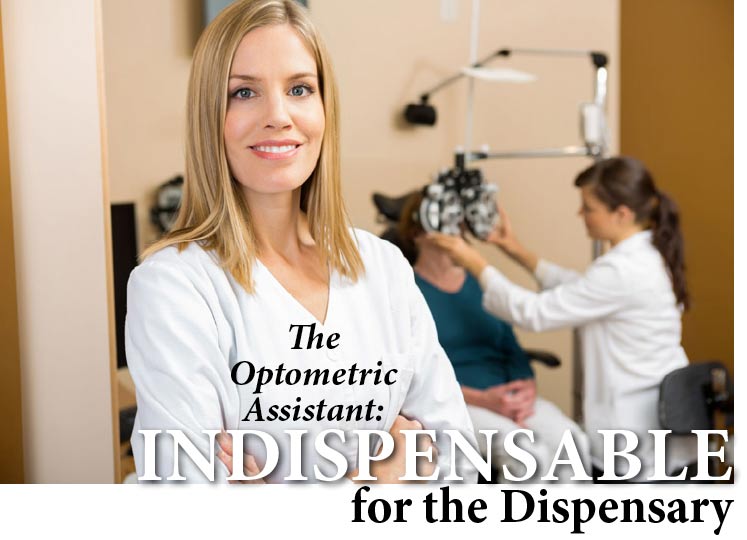By Paddy Kamen
Staffing can be an issue for any small business and with the busy optometric practice even more so, for a tremendous amount of specialized knowledge is required to adequately support doctors and their patients.
Thankfully, the Canadian Association of Optometrists (CAO) helps its members meet the need for comprehensively trained staff. The CAO’s optometric assistant program is a sure way to get the new staff person thoroughly educated in the multi-dimensional aspects of the optometric practice.
Offered in four modules, the online program covers everything from office administration to contact lens instruction for patients, to providing advice to patients on frame and lens selection. Students are also trained in preliminary vision testing, assisting with patient examinations and training in low vision devices.
A location-based workshop completes the training. Held annually in several cities across the country, the workshop is an integral component of the training and attendance is required in order for the student to write the final examination and obtain certification. Graduates are granted a certificate and the designation Canadian Certified Optometric Assistant (CCOA).
Diana Monea is an optometrist with two busy practices in Calgary and one in Regina. She has three optometric assistants (OAs) in each office to support two optometrists and three opticians.
When asked to compare the role of the OA with that of the optician, Monea says that OAs are more like secretaries with special expertise relating to the optometric office. “Opticians have more extensive training and are licensed professionals. They can sign off on prescriptions, whereas everything the OA does has to be supervised by the OD or the optician, as appropriate.”
Joanne Hankey is an optometrist at Complete Eyecare Optometry in Abbotsford, B.C., where they also have both OAs and opticians on staff. « Our optometric assistants book appointments, welcome patients and confirm their client information. They perform screening tests such as auto-keratometry and auto-refraction, as well as non-contact tonometry. Other diagnostic tests such as retinal photography, visual fields and OCT are all done by our OA’s. Our opticians support the optometrists by helping patients find solutions to their vision problems with contact lenses and/or glasses. They advise them of their options and make recommendations based on their own expertise and on the advice of the doctors. They adjust and repair glasses and counsel patients as they adapt to their new eyewear. Because our clinic is large, there is not a huge crossover in roles, though everyone has the same commitment to ensuring the patient receives best care throughout their visit to our clinic. »
Monea says that in order to save money, some optometrists will hire and supervise OAs, who are trained in dispensing, rather than having opticians on staff. “But I’m too busy for that and our doctors don’t have time to go over every prescription. We need the opticians to sign for the prescriptions.” She adds that, in her experience, OAs operate much like student opticians.
Continuing education (CE) is an important factor in job performance and satisfaction for everyone in the eyewear industry, and no less so for OAs. Monea says that optometric association meetings typically include continuing education sessions for OAs and that their employers pay them to attend. Hankey notes that in B.C., most of the CE opportunities for OAs are found at provincial optometric association seminars, on-line, or at occasional in-house sessions.
At least one optical laboratory in the country offers continuing education to OAs as a value-add for their customers. Yvan Bertrand, marketing and business development director for Benson-Edwards Optical, based in Kitchener and London, ON, has created 11 CE courses for OAs. Nine of the courses are accredited, with two pending accreditation. Bertrand also intends to submit the courses for accreditation to the Opticians Association of Canada.
Bertrand is a licensed optician with extensive marketing experience in the industry who loves teaching and enjoys making training fun for participants. He personally delivers CE to small groups at the convenience of the practice, after hours if necessary.
The continuing education delivered by Bertrand is highly practical. “In all our training, we apply the knowledge to the dispensing process,” he explains. “Optometrists see the training as a strong form of support for their practices. When new staff join the practice, when new technologies are introduced, or when staff are promoted or rotated, there is often a need for additional training. Everything we do is generic, pertinent and fun.”
With the cost of replacing staff much higher than the cost of retaining them, education and training is clearly the way to go, especially with positions as responsible and varied as those of optometric assistants. Education through the certification program combined with CE will make for better customer service and increased job satisfaction for employees. As Bertrand points out: “Consumer expectations about the level of service are very high and increased confidence on the part of staff goes a long way toward meeting them.”
For more information on optometric assistant training, please visit http://opto.ca/oa.








